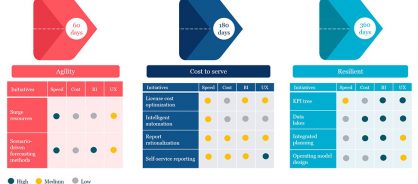- Point of view
Reshaping financial planning and analysis for agility and resilience
How to provide faster, more accurate insights during a pandemic

As the world responds to the ongoing impact of COVID-19, businesses are looking beyond the initial need for remote-working solutions and preparing for what lies ahead. According to the Institute of International Finance in March, “Global growth could conceivably approach 1.0%, far below the 2.6% [recorded] last year and the weakest since the global financial crisis." And large numbers of publicly traded companies have warned investors of the threat Coronavirus poses to their performance and have revised their forecasts for 2020. Because of the nature and scale of the pandemic, many organizations are struggling to model and predict its long-term implications. Their decisions are currently driven by the need to maintain business continuity.
Businesses are turning to their financial planning and analysis (FP&A) teams to guide them through the crisis. But with demands for daily, or even an hourly forecasts, not all are able to meet expectations. We've identified three stages – agility, cost, and resilience – that will help organizations build a more robust FP&A function, enhancing how it informs a company's strategic decision-making.
But first there are challenges to overcome:
- Impact assessment – As the situation evolves, FP&A teams need to constantly update the forecasting models they use to assess the likely impact of COVID-19 on their businesses. They must evaluate new scenarios and planning elements, such as the impact on sales, receivables, the supply chain, and manufacturing production. The traditional planning and forecasting models most organizations still use prevent FP&A teams from completing a comprehensive impact assessment.
- Financial stress testing – As investors and businesses turn to the safety of cash and cash-flow planning, FP&A teams have to run financial stress testing for the worst-case scenarios. This enables their businesses to plan for contingencies and take immediate action. Reviewing current budgets, finding opportunities to conserve cash, postponing some capex projects, and revising forecasts are critical. Organizations that have implemented connected planning and driver-based forecasting will be better placed to respond to change.
- Machine learning – Machine learning (ML) has already made inroads in some organizations' forecasting and planning processes. But in the context of today's black-swan event, some machine-learning-based forecasting models will struggle. ML models thrive on data, but an 'unknown-unknown' like this pandemic can rarely be factored in. This gap in training data can result in the failure of many models. Dealing with a lack of clarity is less about prediction and more about the agility to respond. So, in times of crisis, FP&A teams can modify ML models and bring in new data sets as algorithms need to be trained according to new realities. Live data coming from, for example, the World Health Organization and policy-maker announcements can feed the model for training.
- Balancing business as usual versus additional work – Continuous forecasting and the need for analytics will put immense pressure on FP&A teams that are already inundated with work. Organizations that have broken data models or rely on spreadsheets for reporting will struggle to withstand the disruption created by COVID-19. Prioritizing critical versus nice-to-have activities is key.
- Working from home – FP&A teams are typically not set up to work remotely. The situation demands greater coordination between various functions to continuously assess and increase coordination within the finance team. Organizations that have already adopted global delivery models and remote ways of working with geographically dispersed teams are better equipped to respond to the need for social distancing.
Take a copy for yourself
Steering organizations in disruptive times
FP&A teams play a key role in guiding their organizations through disruption. In Genpact's recent survey of more than 500 senior finance executives, generating actionable insights for the wider business" is among the top-two expectations for finance teams by business leaders for the next two years.
The time frame for meeting the demand for insights has just become much shorter. Coping with uncertainty requires more than just thoughtful analysis. Inaction can be fatal. And the need to make the right decisions at the right time – before competitors do – becomes all-important.
Business leaders across industries are struggling to understand what impact the pandemic will have across their operations, supply chains, customers, vendors, and employees, and are turning to CFOs and their FP&A functions to gain meaningful insights and forecasts. These teams have new data to analyze, insights to generate, and actions to take. Figure 1 shows what this means for different sectors.
Figure 1: How data, insight, and action are changing for FP&A across sectors

With fast-changing scenarios, FP&A teams will refocus their priorities to help the organization continue running and grow in the long run. We believe that FP&A functions should focus on three priorities over three phases in the next two years.
These initiatives can be measured across four dimensions: speed to value, cost, business impact, and user-experience improvement. Figure 2 summarizes how FP&A organizations are reprioritizing initiatives:
Figure 2: Three priorities and phases for FP&A

- Agility (0-60 days): In the first 60 days, FP&A functions must become agile and quick to respond to today's uncertainties. With resources already stretched, teams have to deliver increased reporting, meet business-as-usual needs, and find the capacity to meet their organizations' need for insights and business partnering.FP&A teams also need the right talent to assimilate and process heaps of constantly changing external and internal data points, and analysts to make business sense of the data. As our survey of senior finance executives finds, knowledge of advanced digital technologies and data science are most in demand.
- Cost to serve (60-180 days): When COVID-19 is under control, cost pressures will be immense across support organizations, including FP&A. Optimizing the overall cost to serve the business will be a key priority.For instance, standardizing business intelligence, reporting, and planning tools and licenses can be a quick win. Similarly, driving robotic process automation and report rationalization, and enabling self-service reporting will streamline overall costs and improve the user experience.
- Resilience (180-360 days): FP&A functions will learn from how they adapt and investors will reward organizations that are resilient enough to withstand such unforeseen black-swan events. FP&A organizations can no longer operate in an outdated technology environment and will be forced to reinvent how they operate. Data engineering, integrated planning, business KPI trees, and cloud-based planning solutions will be some of the ways they power this journey. One of the big lessons that has already come from the success of finance professionals working from home is on centralization. FP&A lags in its adoption of centralization, believing that work must be done at the corporate or business headquarters. Implementing a global integrated operating model will generate cost efficiencies that can be reinvested to make the business more resilient for the future.
Looking ahead
As FP&A functions work around the clock to support critical decision-making under testing conditions in the short term, they must transform for the long term, too. They must reprioritize their initiatives – focusing on agility, the cost to serve, and resilience – to help their organizations survive and grow.
The journey starts with teams improving their speed of response as an immediate action and evolves into future-proofing the FP&A functions against new disruptions. This requires organizations to adopt a combination of scalable operating models, integrated business planning, analytics on demand, and business partnering. Only then can FP&A functions be nimble enough to make faster and more strategic contributions.
Learn more about how Genpact can help with enterprise performance management.
This point of view is authored by Vivek Saxena, F&A Service Line Leader; Lavi Sharma, VP, Record to Report; and Kinnar Sanjanwala, VP, FP&A, Genpact.